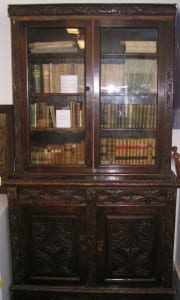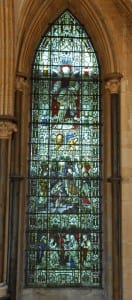Emily Wood
“Work can be made out of anything; there is no need for an audience or stage;” (Lavery, 2005, 232-233)
Framing Statement
The Third Beam was a memorial piece dedicated to a young girl who lost her life at the Lincoln Drill Hall. Overall, the piece was an installation with one-on-one performances that were created and performed on the 4th May 2016. The creation of the installation took place from 12pm until 5pm, with the one-on-one performances occurring at 20 minute intervals between 2pm and 4.35pm. During the creation of The Third Beam, the desired outcome was to educate the audience on the death of Rosamund Acworth, a student who lost her life during a PE lesson. This death was a tragic occurrence. “She climbed up the rope about 3 yards before descending to the ground. She did not fall but came down the rope. When she got to the ground she seemed to collapse. Dr. W A Carline was called to the Drill Hall… he found the girl quite dead and livid” (The Lincolnshire Echo, 1899). The reason that, as a group, we became quite passionate about Rosamund was because her death is poorly documented, and she is not commemorated within the numerous plaques and memorials that are scattered throughout the site. We chose our performance area of the auditorium as this space was used as a gymnasium, and it was also the very room in which Rosamund lost her life.
Whilst audience members could walk freely throughout the space to observe the creation of the installation, the one-on-one performances were collected from the box office, and told to close their eyes upon entering the auditorium so that they could not view the installation in its entirety until the end of the one-on-one performance. Audience involvement took place during the performances. The audience were asked to close their eyes and were lead by the performer, before being instructed to lie down in a specific spot. Without this cooperation, the piece would not have been as efficient.
During the installation, the public were also able to observe the film that was projected on the back of the stage. We had this film playing throughout the 5 hour performance. It depicted the three performers; Megan Avery, Faye Brammah and myself, walking from Lincoln Christ Hospital School to the Drill Hall. These locations were of importance as Rosamund was a pupil at this school when the event occurred.

Through the process, we gained inspiration from the site specific performance artist William Pope L.
Analysis of Process
The first day at the Drill Hall was a guided tour of the building explaining each room, and it uses today. I found this to be very useful, as I had only ever been in the Drill Hall for performances in the auditorium. As Wilkie explains, during the tour, I was encouraged to “engage with the site as symbol” (Wilkie, 2002, 158) The history of the rooms, and the discussion about multiple site specific performances led me to look at the possibilities of the spaces from a site-specific point of view, rather than as a performer. However, the tour did not enlighten me as to a subject I wished to pursue for a performance. Due to this, after the lesson, I went home in search of information into the history of the Drill Hall. Through this research, I found a page linked to the website of Lincoln Christ Hospital School entitled ‘A Memorial to Rosamund Acworth’.
“Rosamund died quite suddenly in the afternoon on Thursday 6th April whilst engaging in physical exercises at the gymnasium in the Lincoln Drill Hall. The Lincolnshire Echo reported that the Coroner described the case as a particularly sad one, as the deceased had suffered a seizure while climbing a rope… According to the Echo report, Rosamund was about three yards up when she seemed to collapse. She then became unconscious and a doctor was immediately called for. Despite efforts by Dr Carline to revive her, these were unsuccessful and Rosamund passed away.” (Harrod and Kupper, 2011)
This article gave an overview of the events of 6th April 1899, but also the memorials that existed for Rosamund within Lincoln. These include a stain glass window within the Cathedral entitled ‘Life Death and Resurrection’. In addition, there are 2 memorials for Rosamund within her school. These are a bookcase engraved with her name, and a prayer desk. This prayer desk is engraved with lilies, her favourite flower. All three of these memorials still exist today. However, the Drill Hall has no memorial to Rosamund.
The constant referral to the article published in the Lincolnshire Echo led me to believe that this article would be very informative. However, the article was not present online. Over the next few weeks, my group and I researched Rosamund, and found some useful sources, but could not find the Lincolnshire Echo article anywhere. However, we had an idea of the space. As the Drill Hall was opened in 1890, and “On the north side of the hall is a gymnasium, 50ft by 30ft”, (The Times, 1890) we were led to believe that this was the place that Rosamund died. This gymnasium would have been within the current auditorium.
We were able to find the Lincolnshire Echo article in the archives of the Lincoln Central Library. This article became very significant for our final performance. The piece explains not only what occurred within the Drill Hall, but also what occurred at her hearing on the 7th April. This gave us more detail into Rosamund’s death. We found that Rosamund epilepsy was the decided cause of death as the Lincolnshire Echo explains “the deceased had had a somewhat similar attack before, which was somewhat in the nature of an epileptic fit… her pulse was beating within two minutes of his arrival. If that were so, death might be due to an epileptic fit” (The Lincolnshire Echo, 1899)
The articles that we had gathered had some common factors that we wished to include in our piece. The fact that Rosamund was the schools fifth form librarian, the inclusion of the rope and the height that she climbed before descending, and the fact that she did not fall, but descended to the ground before collapsing. As we had the auditorium as our space, we were able to use the lighting rig, and decided that we would have a spotlight in the centre of the room as the main focus point. We also wanted to use books within the performance, 17 to be exact as this was her age when she died. In addition to these, the fact that she did not fall down the rope was also one of the main focuses of the journalists. We also wanted to use this within our performance, but were not sure how to incorporate it into our performance.
In the following weeks, during class, we discussed the idea of pilgrimages and the idea of pre-performance, performance and post-performance. We decided that, as a pre-performance that we would walk from the school that she used to attend, to the Drill Hall, recreating her final walk. We decided to film it and have playing on repeat during our performance. Our main inspiration for the pilgrimage was William Pope L. and his performance the Great White Way, 22 miles, 9 Years, One street. Within the piece, Pope L. crawls the length of Broadway on his hands and knees. Due to the significance of the rope, we decided to drag a piece of rope behind us. This would be the same piece of rope that was used in the final performance. We decided on this as it would have also made the final journey that Rosamund took, but also all the dirt from the journey would be collected by it. In addition, we incorporated the oldest clip of an all-female gym class that we could find. We completed the pre-performance walk on the 10th April 2016, the 117th anniversary of Rosamund’s funeral. The final video is as follows:
We decided that for our post-performance, we would perform a memorial to Rosamund by doing the final journey that she never did, and walk back up to the school, and leave a memorial to her outside the gate. Because of the prayer desk that was created by the school in memorial, we decided to take a bouquet of lilies with us to leave outside the gate. We decided to document the journey back up to the school, and this documentation can be found in the video below.
Through feedback from our tutors, during the Easter break, we changed our performance idea radically. We still wanted to perform a memorial piece for Rosamund, with the walk from her school to the Drill Hall being projected onto the wall, and liked the idea of having the spotlight as the only form of light in the auditorium, but changed every other element of the piece. Instead of having the rope on the floor, it would hang from the lighting rig and be lit by the spotlight. We decided on this as it represented the rope that Rosamund would have climbed before descending to the ground. In addition, we decided to knot the rope 3 yards above the floor to show a visual representation of how high she climbed.
I still wanted to use books within the piece due to their significance within the articles, and also the bookcase that in inscribed with her name. After much deliberation, we decided that we would use the books to express the significance of the fact that she did not fall. We decided to create an installation with the pages of the books, starting from edge of the spotlight, ‘she did not fall’ would be written on each page of the 17 books before being ripped out and placed on the floor. Once each book has had all of its pages taken out, the empty cover will be placed face up to show the remnants of the book. These books were used to represent the 17 years that Rosamund lived. We decided to create a memorial to Rosamund to leave within the Drill Hall, and wanted to use some of the pages from the final performance We decided on a small picture frame that would include these pages as well as a picture of Rosamund so that she could be remembered in the Drill Hall’s history. We also decided to use charcoal to write on the pages as we had originally used sharpie, but realized that it was too modern for the piece. Moreover, the charcoal blackened our hands, the way that ink would have blackened the student’s hands in 1899.
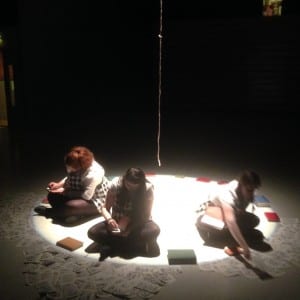
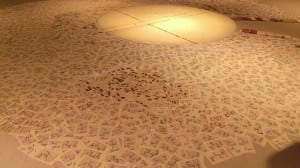
In addition to the installation, we also wanted to include a one-on-one performance. I was interested in the intimacy of the performance between the performer and audience member. In the final weeks of the process, we decided to make a 10-15 minute one-on-one performance to explain our piece in more detail to the audience member. We wanted to give them an overview of what had happened to Rosamund, and what she was like: details that were not included in our performance. For this we decided to bring the audience into the room with their eyes closed, but soon changed this to closing their eyes as soon as they got into the auditorium due to the amount of doors between the box office and the auditorium, making it difficult to navigate when leading the audience member. We wanted to lay the audience member in the spotlight, and in the middle of the installation. This is due to the fact that when we get the audience member to open their eyes at the end of our piece, the first thing they will see is the rope hanging from the lighting rig, and to put them in the place of Rosamund when she collapsed after reaching the ground. For the script of the one-on-one piece, I wanted to make the audience feel as if they were Rosamund. The first thing that we as performers asked was for the audience member to imagine what the Drill Hall would have looked like in 1899. We also interacted with them whilst they were laid on the floor, ‘bathing’ their head and feeling for their pulse. The script also contained verbatim through the use of the Lincolnshire Echo newspaper article. Pieces of the text were recited that described both the time at the Drill Hall as well as the coroner’s report. These verbatim accounts were to remind the audience that our piece was non-fiction.
For our final rehearsal, we used the time to see what the auditorium would look like when it was filled with the pages from the books. When at home, we had ripped out the pages of 17 books, and bought them in to see how much of the space it would fill. In addition, we also practiced a script that I had written the previous night. After performing this and receiving some feedback, we decided that we needed more detail on the memorials, and our intentions for the post-performance, and so I edited the script before it was performed on 4th May.
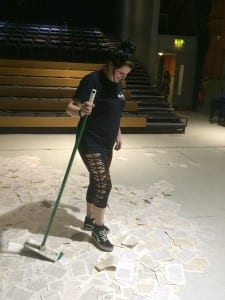
Evaluation of Performance
Overall, I am very pleased with how the piece was executed, and how it was received by the audience. Many of the audience members stayed to watch the process of the installation, and as the auditorium was used as a through-way to performances at the back of the Drill Hall, many people stayed to watch the installation after they had seen another piece.
As all of the spaces for our one-to-one performance were filled, we were able to get a range of people to experience the piece. No audience members were unwilling to be led to the space, nor were they adverse to human contact. The piece would not have worked and had the same effect had the audience member been uncooperative. As Zerihan suggests, “They acknowledge their own visibility and role in the work in one-to-one work in a way that can be ignored as part of a group… Their acknowledged involvement makes the moment potent and alive.” (Zerihan, 2009) During one of my performances however, I did have an elderly lady that could not lie down, and instead I delivered the piece standing, facing her and holding both her hands.
The continuation of the creation of the installation once the one-on-one performances began, I believe, worked particularly well. This is due to the fact that, even though the installation had been developed for 2 hours when these performances began, there were still numerous books left. Moreover, having 2 members of the group working on the piece at a time allowed the piece to expand, and a majority of the books were used through the 5 hour period. However, if we were to perform The Third Beam again, I would like to have some more time, possibly an extra hour, as there were a couple of books left to be added to the installation when we finished the piece.
Overall I feel that we, as a group, were able to complete our initial intention with the piece: raise awareness of Rosamund. Those audience members who were not aware of Rosamund have now been educated about her and her death within the Drill Hall, and we as a group were able to commemorate her within our performance.
Word Count: 2,563
Bibliography
Avery, M. (2016) The Third Beam Pre Performance. [online video] Available from https://www.youtube.com/watch?v=b7p3yRC6vcQ [accessed 12 May 2016]
Avery, M. (2016) The Third Beam Post Performance. [online video] available from https://www.youtube.com/watch?v=9P5i2rGZqI8 [accessed 12 May 2016]
Harrod, P & Kupper, T. (2011) A Memorial to Rosamund Acworth [online] Available from: http://www.christs-hospital.lincs.sch.uk/joomla35/index.php/our-school/lchs-history/school-archive/165-occasional-paper-no-1-a-memorial-to-rosamond-acworth [accessed 9th May 2016].
Lavery, C. (2005) teaching performance studies: 25 instructions for performing in cities. Studies in Theatre and Performance, 25 (3)229-238.
The Lincolnshire Echo (1899) Girl dies in Lincoln Gymnasium. 8th April.
The Times (1890) The Birth of the Drill Hall. 26 May. Available from https://www.lincolndrillhall.com/about-us/the-venue-its-history [accessed 9th May 2016]
Wilkie, F. (2002) Mapping the Terrain: A Survey of Site-Specific Performance in Britain. New Theatre Quarterly. 18 (2) 140 – 161.
Zerihan, R. (2009) Live Art Development Agency Study Room Guide on One to One Performance Available from :https://blackboard.lincoln.ac.uk/bbcswebdav/pid-1155911-dt-content-rid-2084614_2/courses/DRA2035M-1516/DRA2035M-1516_ImportedContent_20150807123831/DRA2035M-1415_ImportedContent_20141103010200/One-to-one%20Performance.pdf [Accessed 12th May]
